A Historical and Musical Walking Tour of German Jewish Washington Heights

Mendelssohn on the Hudson is a self-guided historical and musical walking tour that follows the footsteps of the German Jews and others who fled 1930s Nazi Germany to settle in Washington Heights, also referred to at the time as “Frankfurt on the Hudson.” The self-directed historical tour route – offering autonomy, fresh air, and social distancing – includes West 181 Street to the Heather Garden in Fort Tryon Park, and points in between.
The musical stories presented at their specific locations offer a rare, multi-layered connection between storyteller and listener. It’s an unusual, accessible, and free musical experience via smartphone or another internet-enabled device. During the tour, visitors will hear via podcast twelve episodes with songs based on true field-collected stories from neighborhood residents set to Felix Mendelssohn’s Songs without Words. Each song offers a snapshot of German Jewish life from the 1930s to the near-present. Mendelssohn on the Hudson is unique in combining oral history, musical theatre, classical music, and local landmarks into a compelling record of the German Jewish culture of Northern Manhattan.
Explore and download each episode below.
Prologue: Welcome to Mendelssohn on the Hudson
 181st & Fort Washington Ave, Northeast Corner near Fort Washington Collegiate Church
181st & Fort Washington Ave, Northeast Corner near Fort Washington Collegiate Church
What would you do if your country forced you out, to leave behind everything you loved? Where would you go?
"Mendelssohn on the Hudson" is a historical musical walking tour about the refugees from Nazi Germany, who fled fascism, persecution, and violence in Europe to create new lives in Washington Heights - and transformed a neighborhood.
Our tour takes you on a journey through the past by walking through the present. You can go at your own pace. You'll hear more about composer, artist, and conductor Felix Mendelssohn, as well as ten true stories set to his music, taken from oral histories of local residents who lived in "Frankfurt on the Hudson." Plus, you’ll discover other local history, geography, and architecture unique to Northern Manhattan.
Episode 1: Rose and Eddie (Opus 30, No. 3)
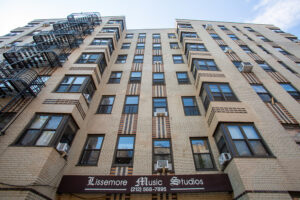 183rd St. and Fort Washington Ave, Southwest Corner
183rd St. and Fort Washington Ave, Southwest Corner
Notice the pre-war Art Deco design of this six-story apartment building at 495 Fort Washington Ave. Throughout the 1930s and corresponding with the arrival of the German Jewish refugees, prominent architects designed buildings like this one to accommodate the area’s growing population.
In 1933, the first year of their anti-Jewish decrees, the Nazis banned Mendelssohn’s music and that of all Jewish-born German composers, toppled Mendelssohn’s statues and destroyed all his other legacies to erase any traces of his existence.
Here, in their adopted country, the German Jews kept Mendelssohn alive. His short piano solos, Songs without Words, or Lieder ohne Worte, were wildly popular; copies of this sheet music were ubiquitous on American German Jewish pianos.
Mendelssohn was present in this building when Eddie, a telephone repairman, realized that Rose, an indigent German Jewish woman, couldn’t pay for her phone repair.
Episode 2: Bracelet (Opus 62, No. 2)
 Western entrance to Bennett Park, east of Pinehurst Avenue between 183rd and 185th Street
Western entrance to Bennett Park, east of Pinehurst Avenue between 183rd and 185th Street
We are at Bennett Park, which was the site of Fort Washington during the Revolutionary War. A plaque on that large rock outcropping also marks the highest point in Manhattan. If you look west on Pinehurst Avenue, you’ll see Hudson View Gardens. Completed in 1925, this lovely Tudor-style complex is on the National Register of Historic Places. For decades, Jews and other minority groups were discouraged from buying homes here.
On November 9, 1938, in Germany, antisemitism reached a new height on what would become known as Kristallnacht, or the “Night of Broken Glass” - as the Gestapo smashed German Jewish-owned store windows, burned centuries-old synagogues, and arrested Jewish men.
One afternoon, while sitting here in Bennett Park, a neighbor shared her memories of that world-shattering night.
Episode 3: Son of Trujillo (Opus 62, No. 4)
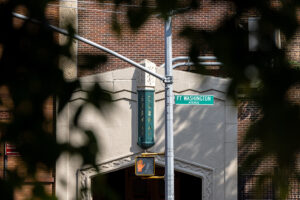 East side of Bennett Park near the steps to Fort Washington Avenue at 184th Street
East side of Bennett Park near the steps to Fort Washington Avenue at 184th Street
We see the Art Deco A-train subway entrance designed by Squire J. Vickers across the street. Our Austrian neighbor Rivke, whose story this episode follows, lived on Bennett Avenue near this subway entrance’s lower level.
It is also within this episode that the neighborhood’s German Jewish and Dominican immigrant stories intersect. After Kristallnacht, most Jews in Nazi-occupied countries tried to leave for any place that would take them, any way they could. The Dominican Republic, under President-Dictator Rafael Trujillo, was the only country that initially proposed to allow an unlimited number of Jews to emigrate there. The son of Trujillo made a promise to Rivke’s husband that will surprise you.
Episode 4: Lillian (Opus 85, No. 6)
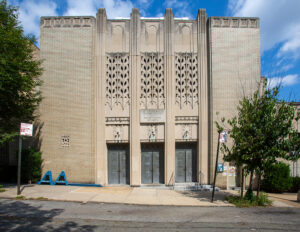 Northwest corner of 185th St. at 551 Fort Washington Avenue
Northwest corner of 185th St. at 551 Fort Washington Avenue
We are outside the current home of the Hebrew Tabernacle of Washington Heights congregation. It owns a copy of the Gedenkbuch, the Book of Remembrance, which memorializes the 150,000 Jews lost within German borders between 1933 and 1945. For the religious, synagogues remained an important part of their lives here.
Lillian, a member of this congregation, tells a story illustrating the close calls that made the difference between emigrating and not being able to leave Europe at all.
Episode 5: Stairs (Opus 19, No. 3)
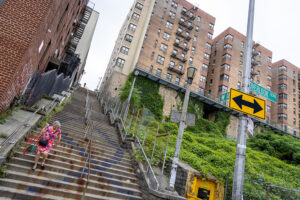 187th Street stairs, just off Fort Washington Avenue
187th Street stairs, just off Fort Washington Avenue
We’re standing near the 187th Street stairs, one of New York’s 102 step streets maintained by the Department of Transportation. Down these steps, west of Broadway, the population was, and still is, largely Orthodox, with several Orthodox synagogues in the area.
The bank next door was the original home of Gideon’s bakery, which became kosher under new ownership by the early 1940s. The supermarket next door used to be a Daitch Shopwell, owned by the Ratners, who were German Jews.
Richie, who grew up across the street from here at 567 Fort Washington, also worked as a soda jerk at Goody’s at #811 on 187th St. in the late 1940’s through the early 1950’s. His first and only love was Wendie June, a Jewish girl who lived up the block. He, like many other neighborhood kids, often hung out at the stairs with his friends and had great stories to tell.
Episode 6: Lotte’s Bad Summer (Opus 67, No. 2)
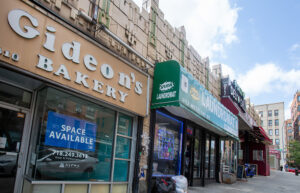 Southwest corner of Fort Washington and 187th outside the bus shelter
Southwest corner of Fort Washington and 187th outside the bus shelter
We’re standing to the side of the busy southwest corner of Fort Washington and 187th outside the bus shelter. Behind us stood Brite Glo, a tiny store that sold everything from marzipan - the sweet almond confection so popular in Germany - to knee-high stockings.
When you follow this corner building around to 187th Street you’ll see a series of one-story storefronts, some with quirky roofs. This geographically unique area can seem like a tiny, elevated island, and the German Jews felt mostly safe here. However, 187th Street was also a popular destination for all Northern Manhattan, and sometimes different groups fought here. Crime grew in the 1960s, worsened in the 1970s, and the late 1980s brought the crack epidemic. The German Jews were frequent targets - they were quiet, mostly kept to themselves, and they were getting older. One neighbor tells the story about a particularly bad summer that began to go wrong right across Fort Washington Avenue.
Episode 7: Diner (Opus 102, No. 5)
 187th St. where Pinehurst Ave., Cabrini Blvd., and 187th St. meet
187th St. where Pinehurst Ave., Cabrini Blvd., and 187th St. meet
We’re standing near the Paterno Trivium, a “vest-pocket” park that commemorates developer Dr. Charles Paterno, whose buildings helped define this residential neighborhood.
For decades, a diner has stood on the northwest side of Fort Washington & 187th Street. Before it was Vicky’s, it was Angela’s Coffee Shop, before Angela’s, Angelo’s...and Mickey’s before that! With their large portions at fair prices, diners were favorite German Jewish hangouts.
Angie lived on Pinehurst, just south of where we’re standing. Sitting in an adjoining padded booth at Angela’s (no relation), she recounted how performing saved her family.
Episode 8: Westphalia (Opus 53, No. 1)
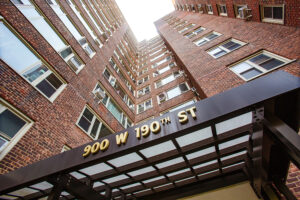 Southwest corner of Cabrini Boulevard & 190th St. outside 900 West 190th
Southwest corner of Cabrini Boulevard & 190th St. outside 900 West 190th
We’re at the southwest corner of Cabrini Boulevard & 190th, in front of 900 West 190th, or Cabrini Terrace. It’s the neighborhood’s tallest and - built in the mid-1950s - one of its newest structures. Saint Elizabeth’s Hospital of Hungary, which was on the northwest corner, served the uptown population until 1981. If you're curious, here's the Revolutionary War Mural of Washington Heights, NYC.
Ursula, who lived on this corner, was in a forced-labor camp at Kassel Bettenhausen when she was a teen. Music saved her life during the nine months she was there, right before the Allies liberated the camp in 1945. Decades later, Ursula shares her story with anyone who’d like to hear it, and she still bursts into song.
Episode 9: Pencil Sharpener (Opus 38, No. 6)
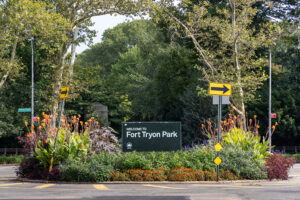 Margaret Corbin Circle at the south entrance of Fort Tryon Park
Margaret Corbin Circle at the south entrance of Fort Tryon Park
We’re at Margaret Corbin Circle, where Fort Washington Avenue meets Cabrini Boulevard, at the southern entrance of Fort Tryon Park. If you sit around the Circle long enough, you might start recognizing the regulars. One particular group of locals - all part of one German Jewish extended family, would meet to catch up on their week.
Martin had been sent with other family members to Theresienstadt, a ghetto and concentration camp the Nazis once used to deceive the International Red Cross. He survived two other labor camps and arrived here with a number tattooed in blue on his arm, from Auschwitz. Another couple, Martin's friends, would walk through the park every day. In later years, they would tell this story of their 60-year marriage that began with one item bought on 181st Street.
Episode 10: Jakob (Opus 19, No. 4)
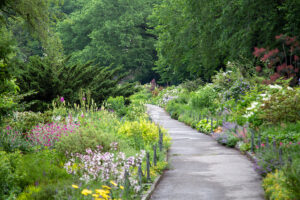 Fort Tryon Park, near the Heather Garden, at the upper stone wall overlooking Billings Lawn
Fort Tryon Park, near the Heather Garden, at the upper stone wall overlooking Billings Lawn
We’re in Fort Tryon Park, near the Heather Garden, at the upper stone wall overlooking Billings Lawn, the Hudson River, and the New Jersey Palisades. You can see how panoramas like this one inspired the area’s nickname, “Frankfurt on the Hudson.” John D. Rockefeller Jr. was instrumental in shaping this Park’s history by donating the old Billings Estate to the Park, as well as the new site for the Cloisters Museum.
The photogenic 67-acre park, completed in 1935, is a place for everyone in and outside the neighborhood to meet and celebrate. Many German Jewish families would enjoy walking and socializing on the park’s main thoroughfare on the Sabbath and holidays. Some of the more observant Jews would carry bread to cast into the Hudson River during the Jewish New Year of Rosh Hashanah. This Park is full of memories for the German Jews who made their home in Washington Heights. Here is one from a widower as he takes his stroll through the park.
Epilogue: Standing on the Shoulders of Giants
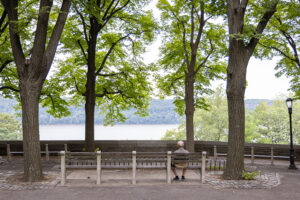 Linden Terrace, Northernmost end of the Stan Michels Promenade in Fort Tryon Park
Linden Terrace, Northernmost end of the Stan Michels Promenade in Fort Tryon Park
We’re at the northernmost end of the Promenade, the David Rockefeller Linden Terrace. Up these stairs there’s another spectacular view of the Hudson River and Palisades.
Today Felix Mendelssohn’s music is once again played in Germany, and his statues and reputation have been restored. New listeners can discover, enjoy, and honor his legacy.
The refugees from Hitler’s Germany are almost gone. A local social service agency in 2021 estimated that around 300 remain in the neighborhood. Every day, new arrivals discover this unique neighborhood for themselves, just as the German Jews and their children did. They leave extraordinary stories, most never told, and some passed on to the next generation, which now includes you.
We hope you enjoyed this historical and musical tour in the footsteps of the German Jews of Washington Heights.
Additional Resources
- Felix Mendelssohn: https://en.wikipedia.org/wiki/Felix_Mendelssohn
- Songs without Words: https://en.wikipedia.org/wiki/Songs_Without_Words
- Fort Tryon Jewish Center: https://www.ftjc.org/
- Hebrew Tabernacle: https://hebrewtabernacle.org/
- YM-YWHA of Washington Heights & Inwood: https://ywhi.org/
- Robert W. Snyder, Crossing Broadway: https://www.amazon.com/Crossing-Broadway-Washington-Heights-Promise/dp/0801449618
- Mother Cabrini Shrine: https://cabrinishrinenyc.org/
- Leo Baeck Institute: https://www.lbi.org/
- Museum of Jewish Heritage: https://mjhnyc.org/
- List of Germany’s Antisemitic Edicts: https://encyclopedia.ushmm.org/content/en/article/antisemitic-legislation-1933-1939
Lyrics, Script, Arrangements: Alison Loeb
Narration: Samuel Guncler
Singers: Bernard Holcomb (“Son of Trujillo,” “Stairs”), Mary Illes (“Bracelet,” “Lottie’s Bad Summer,” “Diner, “ “Pencil Sharpener”), Karen Jolicoeur (“Westphalia,” “Jakob”), Robert Osborne (“Pencil Sharpener”), Laura Pfortmiller (“Rose & Eddie,” “Lillian”).
Pianist: Naoko Aita
Technical Director: Ken Coughlin
Photography: Robbie Bailey
Graphic Design: Jeff Ballard, Lee Kaplan
Nadine Agree, Julia Johnson Attaway, Carolyn “CC” Blackburn, Lee Brock & Seth Barrish, Liz Brody, Nancy Cohen, Shari Colburn, Sarah Durham, Paul Dworin & Ilsa Klinghoffer, Helen Elkiss, Justin Ferate, Amy Gillman & Chris Jones, Mike Gorn and Susan Gorn, Mark Hamburgh, Rose Ann Harris, William Hennessey, Birgit Schwarz-Hickey, Maggie and Darryl Hoffman, Margaret Hornick, Adam Juda, Deborah Katznelson, Shawn Kelly & David Stampley, Emily Kahn, Jonathan Levine, Salty and Larry Loeb, David Lowenberger, Frank Maas, Jeanine McAdam, Neil Mendelson, Judith Michael, Rosa Naparstek, Rose Ellen Neidish, Elizabeth Olson, Linda Padawer & Charlie Kargacos, Andrea Pedolsky, JoAn Relics, Richard Rubinson, Ken Silverman, Morrie Silvert, Robert Snyder, Jane Solomon, Ivelisse Suarez & Mark Levine, Laura Thorpe, Diana Loeb Traylor, Jennifer & Rick Wasserman, and the “Mendelssohn on the Hudson” Kickstarter TeamSpecial thanks: 809 Restaurant and Lounge, Melissa Driscoll, Shulamith Z. Berger, Hermann Teifer, Hope Kaye, Ed Lehner, Hebrew Tabernacle Congregation, Schomburg Center for Research in Black Culture, Robert Rubel, Andrew Dolkart, Jennifer Hoppa, Laurie Tobias-Cohen, JCC of Washington Heights, Hebrew Tabernacle Sisterhood; YM-YWHA Seniors; all our neighbors.
You can support Inwood Art Works free programming by making a tax-free donation.
